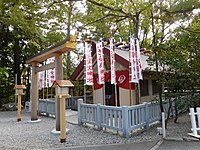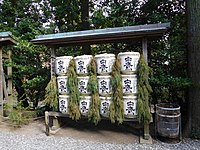Sarutahiko Shrine
You can help expand this article with text translated from the corresponding article in Japanese. Click [show] for important translation instructions.
|
| Sarutahiko Shrine | |
|---|---|
 Shrine | |
| Religion | |
| Affiliation | Shinto |
| Deity | Sarutahiko Ōkami |
Sarutahiko Shrine (猿田彦神社) is a shinto shrine in Ise, Mie.[1] located close to Ise Grand Shrine.[2] It is a beppyo shrine and a Hokora in the modern system of ranked shinto shrines.
The priests of the shrine are direct descendants of Sarutahiko Ōkami.[3] who it worships.[4]
It is linked to Tsubaki Grand Shrine the Ichinomiya of Ise Province.[5][6][7] That shrine is sometimes seen as the head of all Sarutahiko shrines, but other people say this one is.
Mythical origin
[edit]| Part of a series on |
| Shinto |
|---|
 |
Sarutahiko Ōkami (Japanese: 猿田毘古大神, 猿田彦大神) is a deity of the Japanese religion of Shinto; he is the leader of the earthly kami, the kunitsukami[8]
In the Nihon Shoki, he is the one who meets Ninigi-no-Mikoto, the grandson of Amaterasu, the Sun goddess, when he descends from Takama-ga-hara.[9] He is depicted as a towering man with a large beard, jeweled spear, ruddy face, and long nose. At first he is unwilling to let Ninigi pass until persuaded by Ame-no-Uzume-no-Mikoto, the kami of dance and the arts, whom he later marries.[10][11] Even Sarutahiko was regarded as the "god who illuminates the sky and the earth" in Ise, and was worshiped by local believers as the sun god (personification of sun) before Amaterasu.
After guiding the Amatsukami to earth, he rested at the Isuzu River and here this shrine was established
He, Ame-no-Uzume and their children subsequently created the Sarume clan (猿女の君).[12][13][14] clan along with an order of female court and religious dancers. It was the origin of Kagura and Noh. Other descendants includes the Ujitoko clan from Ise province.

See also
[edit]Images
[edit]-
Torii
-
Chozuya
-
Sarume Shrine
-
Pond
-
Sake barrels
References
[edit]- ^ "Dedicated to Sarutahiko Okami, the Kami of Guidance|みちひらきの大神 猿田彦神社".
- ^ Teeuwen, Mark; Breen, John (2017-02-09). A Social History of the Ise Shrines: Divine Capital. Bloomsbury Publishing. ISBN 978-1-4742-7280-3.
- ^ "Dedicated to Sarutahiko Okami, the Kami of Guidance|みちひらきの大神 猿田彦神社". www.sarutahikojinja.or.jp. Retrieved 2023-10-21.
- ^ "Sarutahiko | 國學院大學デジタルミュージアム". 2022-01-22. Archived from the original on 2022-01-22. Retrieved 2023-12-07.
- ^ Yoshiki, Emi (2007). Zenkoku 'Ichinomiya' tettei gaido (in Japanese). PHP Institute. ISBN 978-4569669304.
- ^ "Shinto Portal - IJCC, Kokugakuin University" (PDF). Archived from the original (PDF) on 2012-02-13. Retrieved 2023-12-01.
- ^ Picken, Stuart. (2004). Sourcebook in Shinto: Selected Documents, p. 377; "Nationwide List of Ichinomiya," p. 3 Archived 2013-05-17 at the Wayback Machine; retrieved 2012-8-23.
- ^ Picken, Stuart D. B. (2010-12-28). Historical Dictionary of Shinto. Scarecrow Press. p. 76. ISBN 978-0-8108-7372-8.
- ^ "English" (PDF). 尾張猿田彦神社. Retrieved 14 August 2012.
- ^ "Shrine History". Tsubaki Grand Shrine America. Retrieved 13 August 2012.
- ^ Roberts, Jeremy (2009). Japanese Mythology A to Z. Infobase Publishing. ISBN 978-1-4381-2802-3.
- ^ Picken, Stuart D. B. (2004). Sourcebook in Shinto: Selected Documents. Greenwood Publishing Group. ISBN 978-0-313-26432-0.
- ^ Roberts, Jeremy (2009). Japanese Mythology A to Z. Infobase Publishing. ISBN 978-1-4381-2802-3.
- ^ Coulter, Charles Russell; Turner, Patricia (2013-07-04). Encyclopedia of Ancient Deities. Routledge. ISBN 978-1-135-96397-2.







